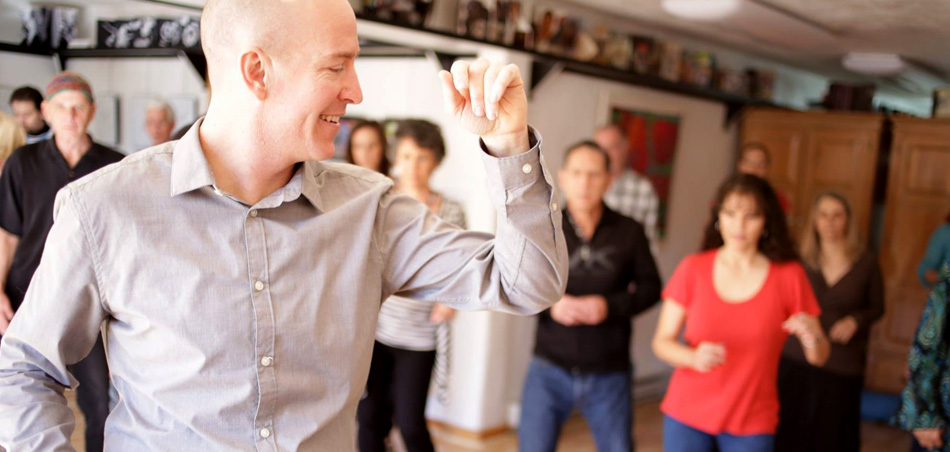Adam Taub is featured in this edition of Dance Spotlight! Adam is a well-known bachata dance instructor, historian and documentarian. He is based in Denver, but travels the globe spreading his love and knowledge of bachata. He was nominated by Edwin Ferreras and Annmarie Löfvenholm.
Annmarie said, “Adam knows the history of bachata. He has lived in the Dominican Republic and he learned the dance from the people there. He travels the globe educating others on bachata and he also introduced many dancers to the wonderful musician, songwriter and bachatero, Joan Soriano.”
Check out a few fun facts and information about Adam including his first memories of bachata and his favorite documentary projects – which you can view in their entirety in this post!
Want to nominate someone to be in the Dance Spotlight? Contact us!
What are your first memories of bachata? How were you introduced to the music and dance?
I first heard bachata in the late ’90s when I was working in Washington D.C. with youth in the city. One of the teenagers gave me a mix tape that had bachata on side-A and rap on side-B. I saw them dancing bachata a little bit. I didn’t learn how to dance in D.C. and the kids didn’t dance very much as partners – but I definitely connected with the music there first. Later, in Colorado, I’d go to clubs and they would play one or two bachata songs per night. They’d have a five minute class and that was my first real introduction to the dance. Those experiences influenced my decision to study abroad for a year in the Dominican Republic and that is where I got a deeper introduction to bachata music, culture and dance.
You have done a lot to educate dancers on the rich history and culture of bachata music and dance. What has been your favorite project thus far?
It has to be the first documentary project that I completed, El Duque De La Bachata (The Duke of Bachata)*. I started that documentary shortly after graduating from the University of Colorado (Boulder). So many of my other projects branched off from that documentary including a film with Joan’s parents (Juana y Cande*). The bachata dance teaching branched off from The Duke of Bachata documentary because I started showing the film at different dance venues during the early days of the bachata festivals. It was shown at the first San Francisco Bachata Festival. I would show the film and then often do a short dance class. The Duke of Bachata is certainly the most influential project that I’ve done. I’ve maintained a friendship with Joan and his knowledge, friendship, and life in general have had a huge influence on how I perceive bachata.
*Both documentaries ( The Duke of Bachata and Juan Y Cande ) are available below for your convenience. They are well worth watching!
Do you have any current projects that you’re working on?
Absolutely! I’ve continued to post documentaries, social dance videos, and interviews with musicians on my YouTube channel. My current goal is to create educational content that will help bachata teachers and dancers.
You recorded the video ‘8 Tips to CONNECT Your Dance Students to music – Bachata teaching tips’. Why do you feel it is important that teachers follow these tips?
I think we recognize intuitively how important music is to dance. It’s surprising how often music doesn’t get the attention it deserves when planning or teaching a dance class. I wanted to recognize how important it is to the dance experience. Dance and music go hand in hand, but that is often overlooked during a dance class. The class becomes more about turn patterns and certain techniques, so those tips capture a variety of ways to connect dancers to the music.
The goal isn’t that teachers do all of these tips perfectly within every dance class, but I wanted to give instructors further awareness of ways music can affect the dance class and enhance their students experience.
Social Dance Pet Peeves? (Hygiene, No connection, People who teach while dancing, etc.)
I would say it’s not about the physical frame or connection – but rather if they are present in the dance and having a good time. I definitely notice if someone is distracted or looking around. I’m happy to do the fundamental steps for the entire dance as long as the person is connected and present – so distracted dancing would definitely be a pet peeve.
One thing that bothers me in general is a lack of respect for others boundaries and safety. Unfortunately, I see that a lot.
You’re a veteran of the bachata dance scene and have witnessed bachata rise from a fringe dance to one that now can be the focal point of festivals/congresses. What are your thoughts on why bachata music and dance have gained such a foothold in the latin dance community?
I think the rise of the internet has played a major role. I found Joan Soriano online through his production company website. After I finished the documentary, I had no idea that bachata festivals existed, but I was able to find and contact organizers of festivals through their websites. The trajectory of my work certainly has been influenced by the internet. If you look at the influential teachers in the late 2010s, and even today, social channels such as YouTube have been a major factor in their exposure and ability to connect to dancers.
Favorite dance video you’d like to share?
One of my favorite videos that I’ve filmed is with Yemy and Alejandra in the Dominican Republic. They’re dancing to music that’s playing from a club nearby where we were filming. I think it’s a spontaneous, organic and high level dance. Getting a spontaneous social dance video in this type of environment that isn’t choreographed is really challenging.

